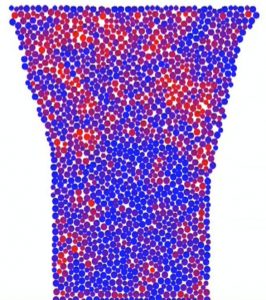We are often taught that the difference between solids and liquids is that in solids, each of the constituent particles has a well-defined average position while in liquids, particles are constantly rearranging and changing their neighbors. In fact, particle rearrangements do occur in solids, and all solids flow under enough stress. Crystalline solids flow via localized particle rearrangements that occur preferentially at structural defects known as dislocations. The population of dislocations therefore controls how crystalline solids flow. In disordered solids, there is considerable evidence that localized particle rearrangements induced by stress occur at localized flow defects. However, for more than 40 years, all attempts to identify them directly from the structure have failed. Here we introduce a novel application of machine learning data mining methods to diagnose flow defects, or “soft” particles from their local structural environments. We follow the softness of each particle as it evolves under stress. Our results show that machine learning methods can be used to gain a conceptual understanding that has not been achieved with conventional approaches.

Snapshot of a two-dimensional experimental granular pillar being compressed by moving the top plate downwards (gravity is into the page). The color of each particle indicates its softness (its structural propensity to rearrange), from a blue (low softness) to red (high softness) scale.
E.D. Cubuk, et al. Phys. Rev. Lett. 114, 108001 (2015).
